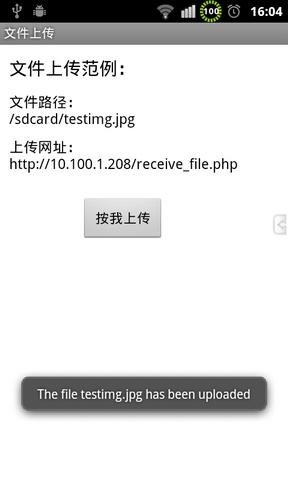Android上傳檔案到Web伺服器,PHP接收檔案(一)
阿新 • • 發佈:2019-02-02
Android上傳檔案到伺服器,通常採用構造http協議的方法,模擬網頁POST方法傳輸檔案,伺服器端可以採用JavaServlet或者PHP來接收要傳輸的檔案。使用JavaServlet來接收檔案的方法比較常見,在這裡給大家介紹一個簡單的伺服器端使用PHP語言來接收檔案的例子。
伺服器端程式碼比較簡單,接收傳輸過來的檔案:
<?php $target_path = "./upload/";//接收檔案目錄 $target_path = $target_path . basename( $_FILES['uploadedfile']['name']); if(move_uploaded_file($_FILES['uploadedfile']['tmp_name'], $target_path)) { echo "The file ". basename( $_FILES['uploadedfile']['name']). " has been uploaded"; } else{ echo "There was an error uploading the file, please try again!" . $_FILES['uploadedfile']['error']; } ?>
手機客戶端程式碼:
package com.figo.uploadfile; import java.io.BufferedReader; import java.io.DataOutputStream; import java.io.FileInputStream; import java.io.InputStream; import java.io.InputStreamReader; import java.net.HttpURLConnection; import java.net.URL; import android.app.Activity; import android.os.Bundle; import android.view.View; import android.widget.Button; import android.widget.TextView; import android.widget.Toast; public class UploadfileActivity extends Activity { // 要上傳的檔案路徑,理論上可以傳輸任何檔案,實際使用時根據需要處理 private String uploadFile = "/sdcard/testimg.jpg"; private String srcPath = "/sdcard/testimg.jpg"; // 伺服器上接收檔案的處理頁面,這裡根據需要換成自己的 private String actionUrl = "http://10.100.1.208/receive_file.php"; private TextView mText1; private TextView mText2; private Button mButton; @Override public void onCreate(Bundle savedInstanceState) { super.onCreate(savedInstanceState); setContentView(R.layout.main); mText1 = (TextView) findViewById(R.id.myText2); mText1.setText("檔案路徑:\n" + uploadFile); mText2 = (TextView) findViewById(R.id.myText3); mText2.setText("上傳網址:\n" + actionUrl); /* 設定mButton的onClick事件處理 */ mButton = (Button) findViewById(R.id.myButton); mButton.setOnClickListener(new View.OnClickListener() { @Override public void onClick(View v) { uploadFile(actionUrl); } }); } /* 上傳檔案至Server,uploadUrl:接收檔案的處理頁面 */ private void uploadFile(String uploadUrl) { String end = "\r\n"; String twoHyphens = "--"; String boundary = "******"; try { URL url = new URL(uploadUrl); HttpURLConnection httpURLConnection = (HttpURLConnection) url .openConnection(); // 設定每次傳輸的流大小,可以有效防止手機因為記憶體不足崩潰 // 此方法用於在預先不知道內容長度時啟用沒有進行內部緩衝的 HTTP 請求正文的流。 httpURLConnection.setChunkedStreamingMode(128 * 1024);// 128K // 允許輸入輸出流 httpURLConnection.setDoInput(true); httpURLConnection.setDoOutput(true); httpURLConnection.setUseCaches(false); // 使用POST方法 httpURLConnection.setRequestMethod("POST"); httpURLConnection.setRequestProperty("Connection", "Keep-Alive"); httpURLConnection.setRequestProperty("Charset", "UTF-8"); httpURLConnection.setRequestProperty("Content-Type", "multipart/form-data;boundary=" + boundary); DataOutputStream dos = new DataOutputStream( httpURLConnection.getOutputStream()); dos.writeBytes(twoHyphens + boundary + end); dos.writeBytes("Content-Disposition: form-data; name=\"uploadedfile\"; filename=\"" + srcPath.substring(srcPath.lastIndexOf("/") + 1) + "\"" + end); dos.writeBytes(end); FileInputStream fis = new FileInputStream(srcPath); byte[] buffer = new byte[8192]; // 8k int count = 0; // 讀取檔案 while ((count = fis.read(buffer)) != -1) { dos.write(buffer, 0, count); } fis.close(); dos.writeBytes(end); dos.writeBytes(twoHyphens + boundary + twoHyphens + end); dos.flush(); InputStream is = httpURLConnection.getInputStream(); InputStreamReader isr = new InputStreamReader(is, "utf-8"); BufferedReader br = new BufferedReader(isr); String result = br.readLine(); Toast.makeText(this, result, Toast.LENGTH_LONG).show(); dos.close(); is.close(); } catch (Exception e) { e.printStackTrace(); setTitle(e.getMessage()); } } }
在AndroidManifest.xml檔案裡新增網路訪問許可權:
<uses-permission android:name="android.permission.INTERNET" />執行結果:

